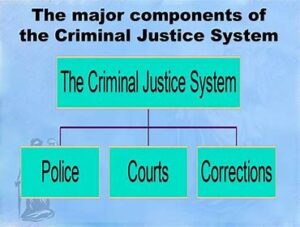Introduction:
Criminal law, also known as penal law or criminal justice law,
is a foundational component of legal systems worldwide,
serving to define and regulate behavior that is considered harmful to
society and prescribing sanctions for violations.
Criminal law encompasses a broad range of offenses, from minor infractions to serious felonies, and plays a crucial role in maintaining social order, protecting individual rights, and promoting public safety. This essay provides a comprehensive examination of criminal law on a global scale, exploring its origins, principles, substantive and procedural aspects, contemporary issues, and comparative analysis across different jurisdictions.
Origins and Development of Criminal Law:
The origins of criminal law can be traced back to ancient civilizations, where early legal codes and systems of justice sought to establish norms of behavior, resolve disputes, and impose punishments for wrongdoing. Ancient legal codes, such as the Code of Hammurabi in Mesopotamia, the Twelve Tables in Rome, and the Code of Justinian in Byzantium, codified rules and regulations governing various aspects of social life, including criminal offenses and penalties.

In medieval Europe, the emergence of feudalism and the growth of centralized states led to the development of common law systems, characterized by the application of customary law, judicial precedent, and royal decrees. The English common law tradition, rooted in principles of equity and fairness, influenced the development of modern criminal law in many jurisdictions, including the United States, Canada, Australia, and parts of Asia and Africa.
The Enlightenment era brought about significant advances in legal theory and jurisprudence, with scholars such as Cesare Beccaria and Jeremy Bentham advocating for principles of proportionality, deterrence, and rehabilitation in criminal justice. Their writings laid the foundation for modern criminal law principles, emphasizing the importance of individual rights, due process, and the rule of law in the administration of justice.
Principles of Criminal Law:
Criminal law is guided by several key principles that underpin its operation and application in legal systems worldwide. These principles serve to ensure fairness, justice, and accountability in the prosecution and adjudication of criminal offenses. Some of the fundamental principles of criminal law include:
- Legality: The principle of legality, also known as the principle of legality or nullum crimen sine lege (no crime without law), holds that an individual cannot be punished for conduct that is not expressly prohibited by law or prescribed as a criminal offense. Criminal laws must be clear, specific, and accessible to the public, and any ambiguities or gaps in the law are construed in favor of the accused.
- Presumption of Innocence: The presumption of innocence is a fundamental principle of criminal law that holds that an accused person is presumed innocent until proven guilty beyond a reasonable doubt. The burden of proof rests with the prosecution to establish the defendant’s guilt through admissible evidence presented in court, and the defendant is not required to prove their innocence.
- Proportionality: The principle of proportionality requires that the severity of punishment be commensurate with the gravity of the offense and the culpability of the offender. Punishments must be fair, reasonable, and proportionate to the harm caused, taking into account factors such as the nature and circumstances of the offense, the offender’s criminal history, and any mitigating or aggravating factors.
- Due Process: The principle of due process guarantees the protection of procedural rights and safeguards for individuals accused of committing a crime, ensuring a fair and impartial trial. Due process rights include the right to legal representation, the right to a speedy and public trial, the right to confront witnesses, and the right to appeal a conviction.
- Mens Rea and Actus Reus: Criminal liability typically requires proof of both actus reus (the guilty act) and mens rea (the guilty mind). Actus reus refers to the physical act or conduct that constitutes the offense, while mens rea refers to the mental state or intent of the offender at the time of the offense. Some offenses may require proof of specific intent, while others may only require proof of general intent or recklessness.
Substantive Criminal Law:
Substantive criminal law defines the elements of criminal offenses, establishes principles of liability, and prescribes penalties for violations. It encompasses a wide range of conduct deemed harmful to society, including offenses against persons, property, public order, and the state. Substantive criminal law is codified in statutes, penal codes, and regulations enacted by legislative bodies, and it serves as the basis for charging individuals with criminal offenses and imposing sanctions upon conviction.
A. Elements of Criminal Offenses:
Criminal offenses consist of various elements that must be proven by the prosecution beyond a reasonable doubt to establish the defendant’s guilt. These elements typically include:

- Conduct: The act or omission that constitutes the offense, known as the actus reus, must be voluntary and intentional to establish criminal liability. The conduct element varies depending on the nature of the offense and may involve physical actions, omissions, or failures to act when there is a legal duty to do so.
- Mental State: The mental state or intent of the offender, known as the mens rea, must correspond to the mental element required for the offense. Mens rea encompasses different levels of culpability, ranging from intentional conduct to recklessness or negligence, depending on the specific elements of the offense and the intent of the legislature.
- Causation: The defendant’s conduct must be the proximate cause of the harm or injury resulting from the offense, and there must be a direct causal link between the defendant’s actions and the prohibited outcome. Causation requires proof that the defendant’s conduct was a substantial and foreseeable factor in bringing about the harm or injury.
- Harm: The offense must result in actual harm or injury to a victim or society, either through physical harm, financial loss, emotional distress, or deprivation of rights or freedoms. The harm element varies depending on the nature of the offense and may involve tangible or intangible consequences of the defendant’s conduct.
B. Principles of Liability:
Criminal liability may be established under different principles of liability, depending on the nature and circumstances of the offense. Some of the key principles of liability in criminal law include:
- Strict Liability: Strict liability offenses do not require proof of intent or knowledge on the part of the defendant, as liability is based solely on the commission of the prohibited act. Strict liability offenses are typically regulatory in nature and involve public welfare offenses, such as traffic violations, environmental violations, and health and safety regulations.
- Vicarious Liability: Vicarious liability, also known as imputed liability, holds individuals or entities responsible for the criminal acts of others, based on their relationship or association with the offender. Vicarious liability may arise in cases of agency relationships, employer-employee relationships, or legal responsibility for the actions of minors or incapacitated persons.

- Corporate Liability: Corporate entities may be held criminally liable for offenses committed by their officers, employees, or agents in the course of their employment or within the scope of their authority. Corporate liability may be based on principles of vicarious liability, negligence, or failure to prevent criminal conduct through inadequate supervision, training, or compliance programs.
- Complicity: Complicity, also known as accomplice liability or aiding and abetting, holds individuals criminally liable for assisting or facilitating the commission of a crime by another person. To establish complicity, the prosecution must prove that the defendant knowingly participated in the commission of the offense and intended to aid or encourage the principal offender in committing the crime.
C. Defenses to Criminal Liability:
Defendants may assert various defenses to criminal liability to challenge the prosecution’s case or mitigate their culpability. Defenses may be based on justifications, excuses, or mitigating factors that negate the elements of the offense or establish grounds for reducing the severity of punishment. Some common defenses to criminal liability include:
- Self-Defense: Self-defense allows individuals to use reasonable force to protect themselves from imminent harm or danger, provided that the force used is proportionate to the threat and necessary to prevent injury or death. Self-defense may also extend to the defense of others or the protection of property from unlawful intrusion or aggression.
- Insanity: The insanity defense asserts that the defendant lacked the mental capacity to understand the nature and consequences of their actions or appreciate the wrongfulness of their conduct at the time of the offense. Insanity may be established through expert testimony and psychiatric evaluations, and defendants found not guilty by reason of insanity may be subject to involuntary commitment or treatment.
- Duress: The duress defense allows individuals to avoid criminal liability if they can demonstrate that they were compelled to engage in unlawful conduct under threat of imminent harm or coercion, and that they had no reasonable alternative to avoid the threat. Duress may be invoked in cases where the defendant acted under duress to protect themselves or others from harm.
- Necessity: The necessity defense permits individuals to justify their actions if they can demonstrate that they were compelled to engage in unlawful conduct to prevent a greater harm or evil, and that there was no reasonable alternative available to avert the harm. Necessity may be invoked in cases of emergency situations or natural disasters where immediate action is required to save lives or property.
V. Procedural Criminal Law:
Procedural criminal law governs the processes and procedures by which criminal offenses are investigated, prosecuted, adjudicated, and punished. It encompasses various stages of the criminal justice system, from the initial investigation and arrest of suspects to trial proceedings, sentencing, and appeals. Procedural criminal law is designed to protect the rights of individuals accused of committing a crime and ensure the fair and impartial administration of justice.
A. Investigation and Arrest:
The investigation of criminal offenses typically begins with the gathering of evidence by law enforcement agencies through various means, such as witness interviews, surveillance, forensic analysis, and search and seizure operations. Once sufficient evidence is obtained, law enforcement officers may seek an arrest warrant from a judicial authority or make a warrantless arrest if they have probable cause to believe that a crime has been committed and the suspect is responsible.
During the arrest process, law enforcement officers must inform the suspect of their rights, commonly known as Miranda rights, including the right to remain silent, the right to legal counsel, and the right to refuse to answer questions without the presence of an attorney. Failure to comply with procedural requirements or violate the suspect’s rights may result in the suppression of evidence or dismissal of charges.

B. Pre-trial Proceedings:
Following arrest, the suspect is brought before a judicial authority, typically a magistrate or judge, for an initial appearance or arraignment, where formal charges are filed, and bail is set. The suspect may also be informed of their rights, advised of the charges against them, and provided with an opportunity to enter a plea of guilty or not guilty.
Pre-trial proceedings may involve various legal motions and hearings, such as motions to suppress evidence, motions for discovery, and motions to dismiss charges, where defense counsel and prosecutors argue legal issues and procedural matters before the court. Pre-trial conferences and negotiations may also occur to facilitate plea bargaining or resolve the case through alternative dispute resolution mechanisms.
C. Trial Processes:
Criminal trials involve the presentation of evidence and arguments by the prosecution and defense before a judge or jury, who determine the guilt or innocence of the accused. The trial process includes several stages, including jury selection, opening statements, presentation of evidence, examination of witnesses, closing arguments, and jury instructions.
During the trial, the prosecution bears the burden of proving the defendant’s guilt beyond a reasonable doubt, while the defense may challenge the prosecution’s case, present evidence, and cross-examine witnesses to raise doubts about the defendant’s guilt. The judge serves as a neutral arbiter, ensuring that legal procedures are followed, and ruling on matters of law, while the jury evaluates the evidence and renders a verdict based on the law and instructions provided by the court.
D. Sentencing and Punishment:
If the defendant is found guilty or pleads guilty, the court proceeds to sentencing, where the judge imposes an appropriate penalty based on the severity of the offense, the defendant’s criminal history, and any mitigating or aggravating factors. Sentencing options may include fines, probation, community service, incarceration, or a combination of sanctions tailored to the individual circumstances of the case.
Sentencing practices vary across jurisdictions and may be influenced by factors such as sentencing guidelines, mandatory minimum sentences, and rehabilitative goals. Courts may consider principles of restorative justice, rehabilitation, and reintegration in sentencing offenders, with an emphasis on addressing underlying causes of criminal behavior and promoting accountability and positive change.
Contemporary Issues and Trends in Criminal Law:
Criminal law is subject to ongoing developments and reforms in response to changing social, political, and technological dynamics. Several contemporary issues and trends have emerged in criminal law, shaping legal frameworks, practices, and responses to evolving challenges. Some of the key contemporary issues in criminal law include:

A. Legal Reforms:
Legal reforms aim to modernize criminal justice systems, enhance procedural fairness, and improve access to justice for individuals accused of committing a crime. Reforms may encompass changes to substantive laws, procedural rules, sentencing practices, and diversionary programs, with a focus on reducing recidivism, addressing racial disparities, and promoting rehabilitation and reintegration.
B. Human Rights Considerations:
Human rights considerations play a significant role in shaping criminal law policies and practices, ensuring respect for fundamental rights and freedoms, such as the right to a fair trial, the right to legal representation, and the right to be free from arbitrary detention or punishment. Human rights principles guide efforts to strengthen due process protections, safeguard the rights of vulnerable populations, and promote accountability for human rights violations in the administration of justice.
C. Responses to Transnational Crime:
Transnational crime poses complex challenges for criminal law enforcement, requiring coordinated responses and international cooperation to combat illicit activities such as drug trafficking, human trafficking, terrorism, and cybercrime. Responses to transnational crime may involve the harmonization of legal frameworks, extradition treaties, mutual legal assistance agreements, and collaborative efforts among law enforcement agencies, judicial authorities, and international organizations to disrupt criminal networks and hold perpetrators accountable across borders.
Comparative Analysis of Criminal Law Systems:
Criminal law systems vary significantly across jurisdictions, reflecting differences in legal traditions, cultural norms, and institutional structures. Comparative analysis of criminal law systems provides insights into the diversity of legal approaches, practices, and outcomes, as well as opportunities for cross-jurisdictional learning and collaboration. Key areas of comparative analysis in criminal law include:
- Substantive Criminal Law: Comparing the elements of criminal offenses, principles of liability, and sentencing practices across different legal systems to identify commonalities, differences, and trends in legal standards and norms.
- Procedural Criminal Law: Analyzing the procedures and practices governing criminal investigations, pre-trial proceedings, trial processes, and sentencing practices in various jurisdictions to assess the effectiveness, efficiency, and fairness of criminal justice systems.
- Legal Reforms and Innovations: Examining legal reforms, policy initiatives, and innovative practices in criminal law enforcement, prosecution, and adjudication to identify best practices, emerging trends, and opportunities for cross-jurisdictional collaboration.
Conclusion:
Criminal law is a foundational component of legal systems worldwide, serving to define and regulate conduct deemed harmful to society and prescribe sanctions for violations. It encompasses a broad range of offenses, principles, and procedures that shape the administration of justice and safeguard individual rights and freedoms. By exploring the origins, principles, substantive and procedural aspects, contemporary issues, and comparative analysis of criminal law systems, this essay provides insights into the complexity and diversity of criminal law on a global scale, highlighting its significance in shaping legal and societal norms and promoting justice and public safety.



